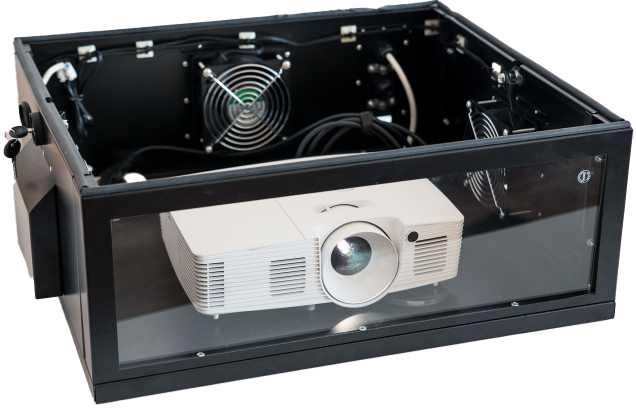
Projection simply doesn't happen without a lot of bright light at consistent levels. Consistent levels of light bright enough to project images don't come without a fair amount of heat. And heat is bad for electronics. If you have hot enough temperatures bearing down on your circuit boards, their lifespan will be significantly shortened, if they don't just fry outright. See how we might have a problem here? Without a way to release that heat in your projector, your outdoor cinema event might not even make it through the opening credits.
To avoid overheating, projectors come with 2 or 3 small fans which help push air through the projector's electronics to keep everything nice and cool. However, air often contains dust and other small particles which need to be filtered out before the air can safely pass through the operating parts. Of course, all of that dust and gunk doesn't just magically disappear. All of those particles stay right there on the filter. If the particles are allowed to build up enough over time, eventually all the passages will become too clogged for any air to get through. The filtration system then becomes a blanket of insulation, which traps all the heat in the projector and causes the whole machine to break down. To prevent such a thing from happening in the middle of your event, we're going to go over all the ins and outs of filter care in this post.
How Often Should You Clean Your Filters?
The answer to this question ultimately depends on the particular nature of your usage. How often do you use the projector? Do you use it primarily indoors or outdoors? When was the last time you clean it? The easy answer is that you should clean your projector's filters whenever you notice an excess buildup of dust. If you're not the type that notices those kinds of things regularly, try to clean it once for every 100-300 hours you use it, depending on how dusty your environs typically are.
Learn the Warning Signs
Most projectors on the market today come with a little LED temperature warning light. Depending on the state of your filters, the LED will light up in different ways. If your projector displays an orange flashing light, it means that the projector is starting to heat up a little too much. If the light is flashing red, it means that there is a problem with a cooling fan or the sensor. If the light is a solid red, it means that you are dancing perilously close an automatic shutdown due to overheating. In any case, all of these warning lights offer a good indicator that it's time to clean your filters. If for some reason your projector doesn't come with warning lights, then watch for erratic behavior or look for a large build-up of dust on the air vents.
How to Clean Your Filters
Remember that cleaning your electronic equipment is certainly not like washing your car or doing the dishes. It's not even like when you're dusting the mantle with a damp paper towel. You don't want to get water near anything on your projectors, even the filters. The best way to remove unwanted dust and other particles is with air. You can either use a small vacuum cleaner to suck the dust away or you can use a small canister of compressed air to blow the dust away. Keep at it until it looks like everything has been cleared out.
Remember the Filter Cabinet
It doesn't make much sense to clean your projector's filter and then place the thing back in the dirty, dust-filled compartment where it was sitting before. So, be sure to take that can of compressed air and give the filter cabinet a good spraydown as well. You can, of course, use a small vacuum as well. If you don't happen to have either, use a dry, lint-free cloth. And, if there happens to be a lot of dust caked in there and less easy to remove, a mild detergent is acceptable, but remember not to use anything too harsh = no solvents or thinners.
Just like any tool in your gearbag, the more regular care you give your projector, the more regularly it will work for you. Be sure to abide by the 100-300 hour rule at the very least. Take care of your projection equipment and it will afford you hours upon hours of cinematic magic.







when you lost sponge or damaged what other tool can be used to replace those sponge of airfilter
when you lost sponge or damaged what other tool can be used to replace those sponge of airfilter